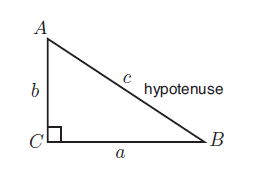Pythagoras' Theorem
Definition
Pythagoras' Theorem relates the lengths of the sides in a right-angled triangle:
 $\qquad\qquad\qquad c^2 = a^2 + b^2$
$\qquad\qquad\qquad c^2 = a^2 + b^2$
The long side is called the hypotenuse.
Worked Examples
Example 1
The two shortest sides of a right angle triangle are $5$ and $2$. Find the length of the hypotenuse.
Solution
Recall the formula $c^2 = a^2 + b^2$. We wish to find the hypotenuse, $c$, and are given $a=5$, $b=2$.
\begin{align} c^2&=a^2+b^2\\ c^2&=5^2+2^2\\ c^2&=25+4\\ c^2&=29\\ c&=\sqrt{29} \end{align}
Note: We get a positive and a negative answer when we take a square root. However, lengths of sides can never be negative so we take the positive square root.
Example 2
A right-angled triangle has hypotenuse of length $9$ and a side of length $3$. Find the length of the other side.
Solution
This time we are given the length of the hypotenuse and one of the other sides is unknown. Start by rearranging the Pythagorean formula to make the unknown length the subject.
\begin{align} c^2&=a^2+b^2\\ b^2 &= c^2-a^2 \end{align}
We are given $c=9$, $a=3$. Substitute these into the equation and solve for $b$.
\begin{align} b^2&=c^2-a^2\\ b^2&=9^2-3^2\\ b^2&=81-9\\ b^2&=72\\ b&=\sqrt{72}\\ &= 6\sqrt{2} \end{align}
Note: Don't forget to take the square root at the end; the length is $b$, not $b^2$.
Video Example
Prof. Robin Johnson applies Pythagoras' theorem to find the length of a side of a triangle.
External Resources
- Pythagoras' Theorem workbook at mathcentre.